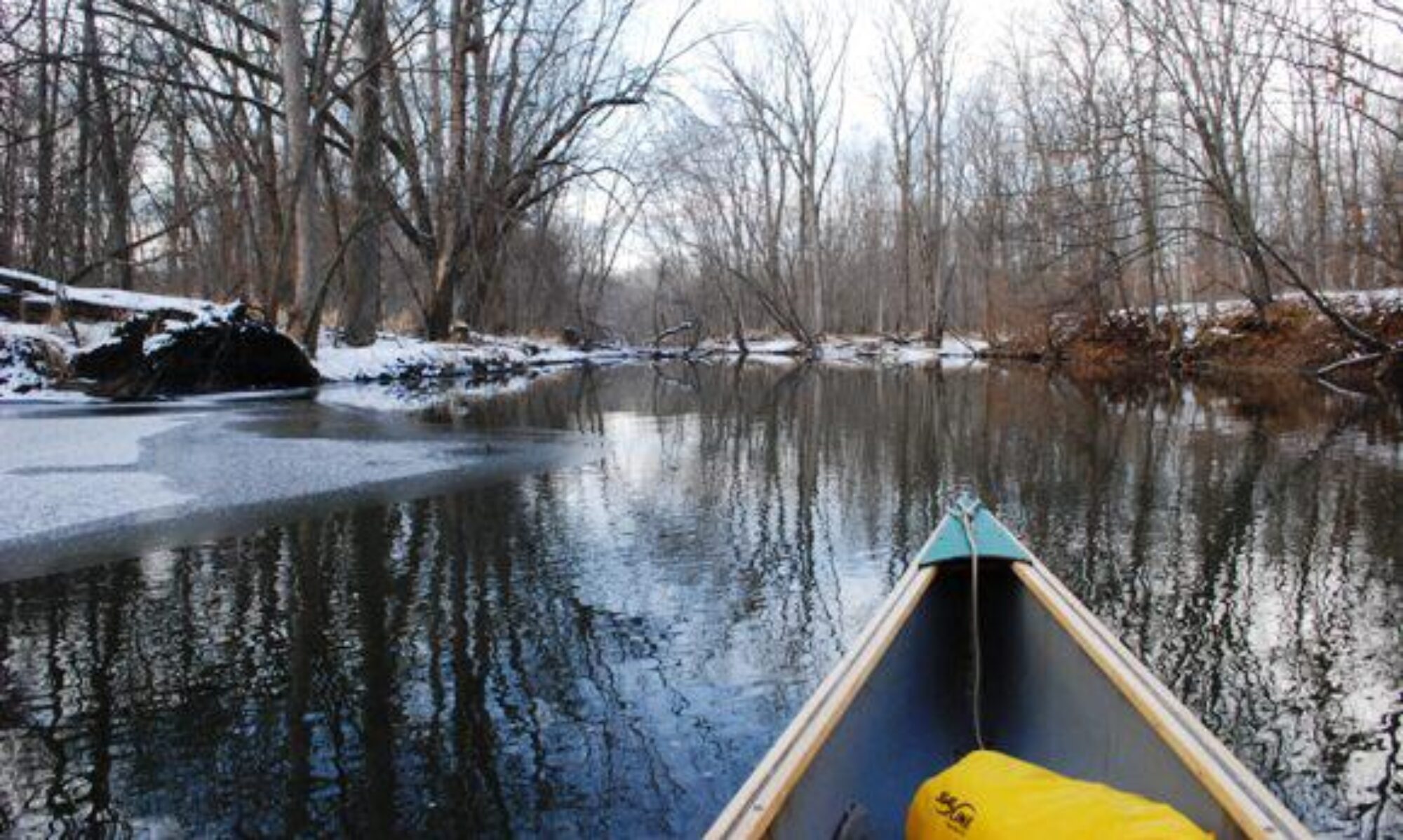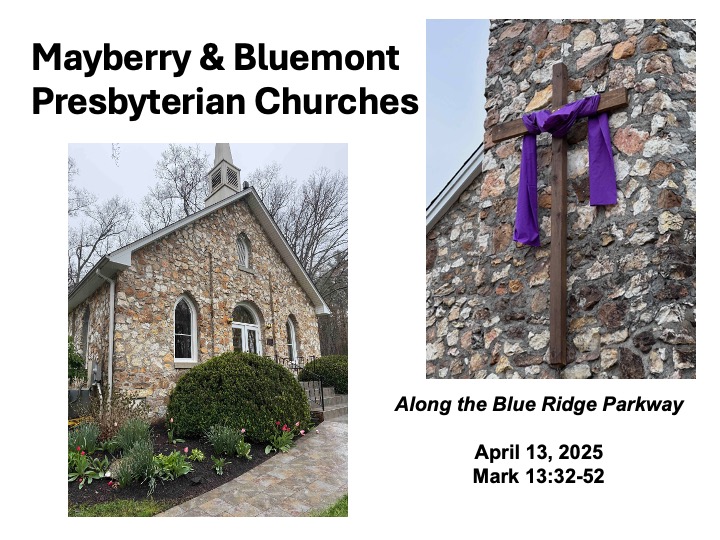Jeff Garrison
Mayberry and Bluemont Churches
April 13, 2025
Mark 14:32-52
At the beginning of worship:
It’s good to be back, but I can’t say I enjoyed being gone. My thanks to Carol Strickland for preaching for me two weeks ago as I recovered from a nasty stomach bug. I have never been so sick as an adult. I know some of you have also had the bug. My condolences. For the rest of you, avoid it if you can. It’s a terrible way to lose a few pounds.
Last week, I was scheduled to be away and had lined up Carl Utley to preach. I attended the HopeWords Writers Conference in Bluefield, West Virginia. The speakers were outstanding, but it corresponded to a high pollen count and my head pounded the entire weekend. Hopefully, the worse of the pollen is over…
Today is Palm Sunday is also known as Passion Sunday. Last year, my passage for the sermon was Jesus’ crucifixion as told by Mark-obviously a sermon on the passion.[1] Since I covered Mark’s recount of Palm Sunday back in November,[2] this Passion Sunday, I want us to focus on Jesus’ time in the Garden of Gethsemane. The Passion of Jesus involves more than the cross. It includes all the events of the last days of his life, from the Passover, through the crucifixion, death, and burial.[3]
I’ve been reading Fleming Rutledge’s The Crucifixion: Understanding the Death of Jesus Christ over the past week. This is her magus opus, the great work of her career, as she attempts to show how everything about our faith rises and falls at the cross. She’s not the first one to suggest this. The Apostle Paul wrote to the Corinthians, “For Jews demand signs and the Greeks desire wisdom, but we proclaim Christ crucified…”[4]
Sadly, as Rutledge points out, much of American Christianity skips over the crucifixion. We want to go from the parade in Jerusalem straight to the resurrection and skim over Jesus’ agony of the Garden and his suffering on the cross. But when we do that, we miss out what God has and is doing for us. This week, take time to comprehend what God has done for us. As Paul writes, “While we were sinners, Christ died for us.”[5] What does that mean?
Before reading the Scripture:
Today, we’re looking at Jesus’ passion which starts in the Garden of Gethsemane. Gethsemane means olive press. The garden, located in the Kidron Valley, just below the Mount of Olives, would have been the perfect place for such a press.
Also important for us to understand is that during the Passover, the Jewish pilgrims remained in Jerusalem not only for the evening meal but throughout the night. Because so many people crowded into Jerusalem during this time, a city of 50,000 ballooning to a quarter million by some estimations, they expanded the city’s boundaries beyond the walled areas. They considered Gethsemane and the Mount of Olives a part of the city. However, Bethany, where the disciples had been staying, was outside the boundaries. This is another reason they would not have gone back to where they had lodged during this night.
The Passover was a celebration meal that lasted for several hours. It would have broken up around midnight after lots to eat and four glasses of wine. The lateness of the hour and the food and drink helps explain what happens in the garden. After the meal, Jesus leads the disciples to Gethsemane. The moon would have been full, as it was the Passover.
Furthermore, we can imagine groups of the faithful sitting around fires around the city, after having celebrated earlier in the evening. This provides the setting for the events that take place as we’ll hear.
Read Mark 14:32-52
Our passage displays the faithfulness of Jesus and the lack of faith of the disciples. But Jesus’ decision to remain faithful out of obedience to the divine plan causes him great internal agony. What happened in the garden this night of his arrest, reminds us that Jesus is not just divine, but is also a human being who fears what’s ahead. In prayer, he submits to his divine will even though the temptation to run away is great.
According to our passage, most of the disciples (perhaps all except for Judas) go with Jesus to the garden. But outside the garden, he tells all but his inner core (Peter, James, and John), to sit and wait. He then proceeds into the garden, asks the three to wait close by and to pray. He steps away to pray by himself.
Jesus’ prayer is full of agony. Normally, Jewish men would pray standing up, but here Jesus throws himself on the ground. The reality of Jesus’ grief is apparent. As one commentator noted, there is nothing in scripture that compares to the grief shown in Gethsemane—not in the Psalms of Lament or with Abraham when he thought he was going to have to sacrifice Issac, or in David’s grief over the death of Absalom.[6] Luke tells us that Jesus sweated blood.[7]
Since Jesus first foretold his death in Mark 8, he has been focused on Jerusalem. The disciples question what’s going to happen, but Jesus moves forward. But now, with things about to spin out of control, Jesus pauses to pray. He realizes what is required of him to save humanity from sin.
The cup of which Jesus speaks of links the Lord’s Supper with the crucifixion. This isn’t a simple death. It’s not just a painful death. Jesus, on the cross, accepts the consequences of sin, which alienates us from God. He accepts such alienation on himself, by surrendering to the sinful and taking on the sins of the world.
Jesus ends his prayer not demanding his own will but by surrendering to the Father’s. Here, we’re reminded of that important line in the Lord’s Prayer, “Thy will be done.”
While today, we don’t spend much time on Gethsemane, except for maybe on Maundy Thursday. But this event impressed the early church. The Jesus depicted at Gethsemane carries a level of authenticity, for who would describe their hero questioning what is about to happen.[8] Jesus in Gethsemane isn’t Socrates, who Plato describes willing drinking the poison hemlock without complaint. But again, his death involves so much more. And while Mark has throughout his gospel pointed out the divine nature of Jesus, here we see his bare humanity. He experiences the same fear and uncertainty we all face.
When Jesus goes back to check on the disciples, he finds the three asleep. He speaks to Peter, but instead of using the name Peter, which means “rock,” he uses his older name, “Simon.” Perhaps this was because Peter is not rock solid at this point.
However, we shouldn’t forget that it’s been a long day and after a big meal with plenty of drink. So it’s understandable that Peter and the disciples can’t stay awake. This happens twice more, before Jesus says, “Enough,” and arouses the three sleeping disciples. They go to meet the betrayer.
Again, as Mark does whenever Judas is mentioned, we’re reminded that he’s one of the 12.[9] Mark doesn’t let us forget this. The betrayal is an inside job.
Judas comes with a mob from the Sanhedrin. He kisses Jesus to identify him, which is an odd sign. We know in the ancient world, disciples would often kiss their master on the cheek, but this is the only occasion in which we’re told Jesus received such a kiss. But this kiss of betrayal sets off the events that will lead to Jesus’ crucifixion. But even here, we see that Jesus is in control as he surrenders to the powers sent to arrest him.
Then “All” the disciples desert him. At the table, after Peter declared his unfailing allegiance to Jesus, we’re told that All the disciples agreed to stand fast.[10] Now we see that’s not the case.
This section ends with a funny story about a young man who may have been asleep and heard the commotion and came out with only the linen cloth worn in bed. When the authorities try to grab him, he runs always naked, leaving them holding the cloth. It’s interested and we don’t know who this person was, although some think it may have been Mark’s way of acknowledging his presence at the betrayal.[11]
While it wasn’t really a dark night, for the full moon would have shown brightly across the valley, it was a night filled with dark events. Jesus remains faithful to his divine plan, but all the disciples abandon him. Yet, there’s good news here. For our hope is not based on our faithfulness. If that’s the case, we’ll liable to be just like the disciples. Instead, our hope (and the disciples hope) is based only on God coming to us in the life of Jesus. In him, God willing gives his life for ours. Amen.
[1] See https://fromarockyhillside.com/2024/03/24/jesus-crucifixion-as-told-by-mark/
[2] See https://fromarockyhillside.com/2024/11/17/7549/
[3] Fleming Ruthledge, The Crucifixion: Understanding the Death of Jesus Christ, (Grand Rapids, MI: Eerdmans, 2015), 65.
[4] 1 Corinthians 1:22-24.
[5] Romans 5:8.
[6] James R. Edwards, The Gospel According to Mark (Grand Rapids, MI: Eerdmans, 2002), 432.
[7] Luke 22:44.
[8] See Edwards, 432 and Morna D. Hooker, The Gospel According to Saint Mark (1991, Hendricks Publishing, 1997), 349.
[9] See Mark 14:10. In Mark 3:19, instead of being referred to as “one of the twelve,” Judas is identified as the betrayer (the one who handed him over).
[10] Mark 14:31.
[11] Edwards, 440-441.Douglas R. A. Hare, Mark: Westminster Bible Companion, (Louisville, KY: WJKP, 1996), 197-198.


I still remember my worst adult sick and it was years ago!
Sadly, I think I’ll remember this for a long time. I ended up in the hospital getting IVs and nausea shots as my blood glucose levels kept dropping.
Wow. What an awful bug. Glad you are on the mend, Jeff, and feeling better.
Thanks! This is a busy week, so I need to be well.
I’m glad you’re feeling better. It sounds like an awful bug! The worst of the pollen is over here, but there are still plenty of allergens blooming.
I have that Fleming Rutledge book on my wish list. I love her writing/preaching.
Fleming Rutledge is a gift. This book is different that the others as it’s not just sermons unlike many of her other books.
I’m glad you’re feeling better. It’s never fun to be that sick.
Yes, it was not fun at all!